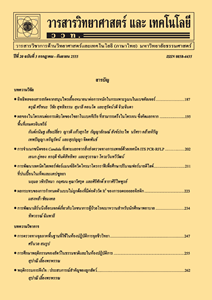ความเป็นพิษต่อเซลล์มะเร็งเต้านมและเซลล์มะเร็งลำไส้ใหญ่ของสารสกัดหยาบฮว่านง็อก
Main Article Content
Abstract
บทคัดย่อ
งานวิจัยนี้มีวัตถุประสงค์เพื่อวิเคราะห์ปริมาณและตรวจหาองค์ประกอบทางเคมีในใบและลำต้นฮว่านง็อก รวมถึงศึกษาความเป็นพิษต่อเซลล์มะเร็งเต้านมและเซลล์มะเร็งลำไส้ใหญ่ของสารสกัดหยาบใบและลำต้นฮว่านง็อก โดยนำใบฮว่านง็อกแห้งและลำต้นฮว่านง็อกแห้งมาสกัดด้วยเอทานอลโดยการแช่ยุ่ย (maceration) ระเหยตัวทำละลายออกด้วยเครื่องระเหยสุญญากาศและเครื่องทำแห้งแบบเยือกแข็ง นำสารสกัดหยาบใบและลำต้นฮว่านง็อกที่ได้ไปหาปริมาณฟีนอลิกทั้งหมด แทนนินทั้งหมด และฟลาโวนอยด์ทั้งหมดด้วยเทคนิคยูวี-วิสิเบิลสเปกโทรโฟโทมิเตอร์ และตรวจหาสารสเตอรอยด์-เทอร์ปีน (steroid-terpenes) แอลคาลอยด์ (alkaloid) และฟลาโวนอยด์ (flavonoid) ด้วยเทคนิค TLC fingerprint นำสารสกัดหยาบใบและลำต้นฮว่านง็อกไปศึกษาความเป็นพิษต่อเซลล์มะเร็งเต้านมโดยใช้ MCF-7 เซลล์ไลน์ และศึกษาความเป็นพิษต่อเซลล์มะเร็งลำไส้ใหญ่โดยใช้ Caco2 เซลล์ไลน์ ทดสอบความเป็นพิษต่อเซลล์มะเร็งด้วยเทคนิค MTT assay ผลการวิจัยพบว่าสารสกัดหยาบใบและลำต้นฮว่านง็อกที่สกัดด้วยเอทานอลมีร้อยละผลผลิตเท่ากับ 11.91 และ 2.32 มีปริมาณฟีนอลิกทั้งหมดเท่ากับ 1.80 และ 1.64 mg of gallic acid/1 g of sample ปริมาณแทนนินทั้งหมดเท่ากับ 1.85 และ 1.68 mg of tannic acid/1 g of sample และปริมาณฟลาโวนอยด์ทั้งหมดเท่ากับ 40.52 และ 40.71 mg of rutin/1 g of sample ตามลำดับ ตรวจพบสารสเตอรอยด์-เทอร์ปีนส์และฟลาโวนอยด์ แต่ตรวจไม่พบแอลคาลอยด์ในใบและลำต้นฮว่านง็อก โดยสารสกัดหยาบใบฮว่านง็อกมีความเป็นพิษต่อเซลล์มะเร็งเต้านม (MCF-7 เซลล์ไลน์) มีค่า IC50 เท่ากับ 593 µg/ml ส่วนสารสกัดหยาบลำต้นฮว่านง็อกไม่มีความเป็นพิษต่อเซลล์มะเร็งเต้านมมีค่า IC50 มากกว่า 5,000 µg/ml สารสกัดหยาบใบและลำต้นฮว่านง็อก มีความเป็นพิษต่อเซลล์มะเร็งลำไส้ใหญ่ (Caco2 เซลล์ไลน์) มีค่า IC50 เท่ากับ 455 และ 620 µg/ml ตามลำดับ
คำสำคัญ : สารสกัดหยาบฮว่านง็อก; ความเป็นพิษต่อเซลล์; มะเร็งเต้านม; มะเร็งลำไส้ใหญ่
Abstract
This study aimed to (1) analyze and identify the chemical compounds in leaves and stems of Pseuderanthemum palatiferum (Nees) Radlk., and (2) study cytotoxicity of crude extract of P. palatiferum leaves and stems in breast and colon cell lines. These leaves and stems were dried and macerated with ethanol, and the ethanolic extract was evaporated under a reduced pressure condition and then freeze dried. The P. palatiferum crude extracts were analyzed for total phenolic, tannin and flavonoid content using UV-Vis spectrophotometry. Moreover, steroid-terpene, alkaloid and flavonoid were identified by TLC fingerprints. The MTT assay was used to test cytotoxicity of P. palatiferum in the MCF-7 and Caco2 cell lines, which were used as a representative line of breast and colon cell lines, respectively. The results were as follow: (1) The total phenolic contents of crude extracts of P. palatiferum leaves and stems were 1.80 and 1.64 mg of gallic acid/1 g of sample, respectively whereas their total tannin contents were 1.85 and 1.68 mg of tannic acid/1 g of sample, respectively. Moreover, the total flavonoid contents of crude extracts of P. palatiferum leaves and stems were 40.52 and 40.71 mg of rutin/1 g of sample, respectively. The results of TLC fingerprint analyses showed steroid-terpene and flavonoid but no alkaloid. (2) The crude extract of P. palatiferum leaves was toxic to MCF-7 cells with an IC50 value of 593 µg/ml, but the crude extract of its stems was not toxic to these cells with an IC50 value of more than 5,000 µg/ml. Both leaf and stem extracts were toxic to Caco2 cells with IC50 values of 455 and 620 µg/ml, respectively.
Keywords: Pseuderanthemum palatiferum (Nees) Radlk.; cytotoxicity; breast cancer; colon cancer


